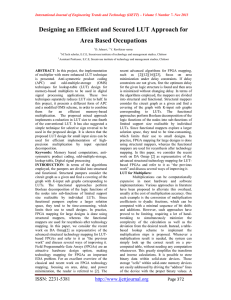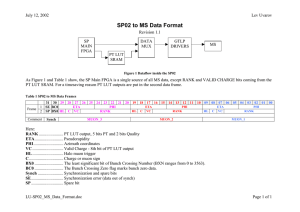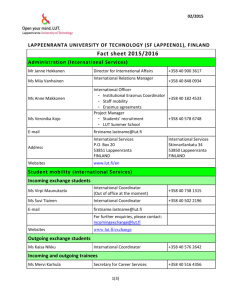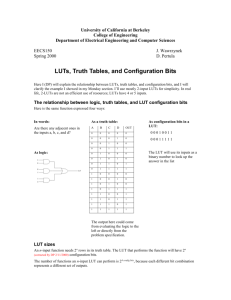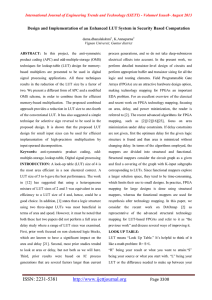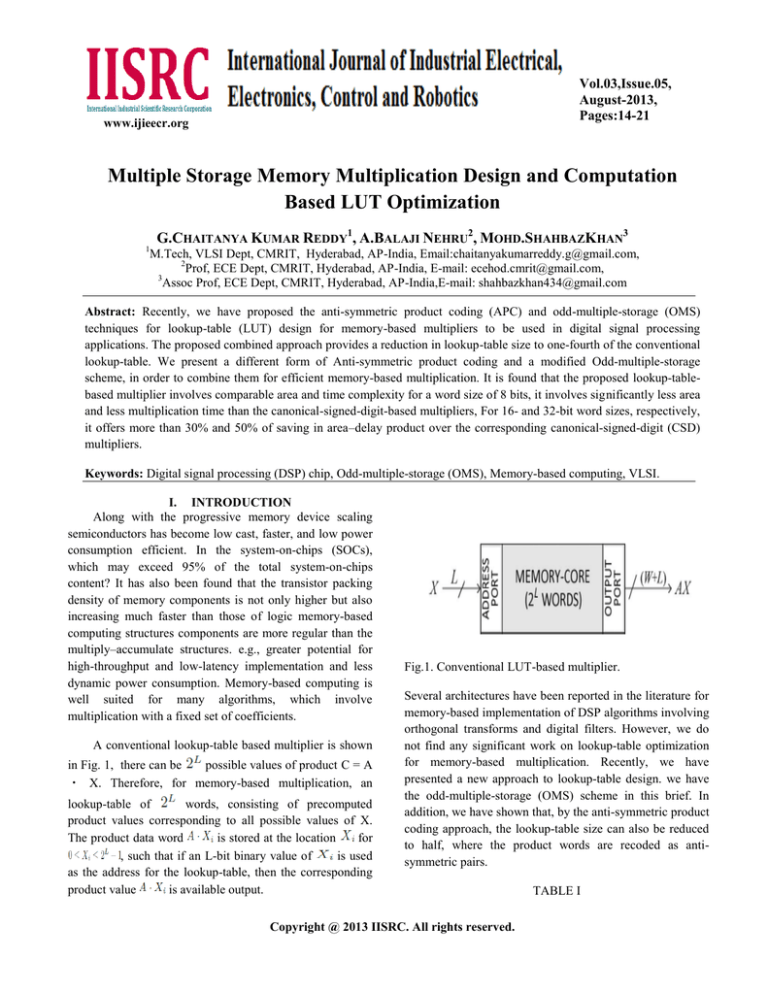
Vol.03,Issue.05,
August-2013,
Pages:14-21
www.ijieecr.org
Multiple Storage Memory Multiplication Design and Computation
Based LUT Optimization
G.CHAITANYA KUMAR REDDY1, A.BALAJI NEHRU2, MOHD.SHAHBAZKHAN3
1
M.Tech, VLSI Dept, CMRIT, Hyderabad, AP-India, Email:chaitanyakumarreddy.g@gmail.com,
2
Prof, ECE Dept, CMRIT, Hyderabad, AP-India, E-mail: ecehod.cmrit@gmail.com,
3
Assoc Prof, ECE Dept, CMRIT, Hyderabad, AP-India,E-mail: shahbazkhan434@gmail.com
Abstract: Recently, we have proposed the anti-symmetric product coding (APC) and odd-multiple-storage (OMS)
techniques for lookup-table (LUT) design for memory-based multipliers to be used in digital signal processing
applications. The proposed combined approach provides a reduction in lookup-table size to one-fourth of the conventional
lookup-table. We present a different form of Anti-symmetric product coding and a modified Odd-multiple-storage
scheme, in order to combine them for efficient memory-based multiplication. It is found that the proposed lookup-tablebased multiplier involves comparable area and time complexity for a word size of 8 bits, it involves significantly less area
and less multiplication time than the canonical-signed-digit-based multipliers, For 16- and 32-bit word sizes, respectively,
it offers more than 30% and 50% of saving in area–delay product over the corresponding canonical-signed-digit (CSD)
multipliers.
Keywords: Digital signal processing (DSP) chip, Odd-multiple-storage (OMS), Memory-based computing, VLSI.
I. INTRODUCTION
Along with the progressive memory device scaling
semiconductors has become low cast, faster, and low power
consumption efficient. In the system-on-chips (SOCs),
which may exceed 95% of the total system-on-chips
content? It has also been found that the transistor packing
density of memory components is not only higher but also
increasing much faster than those of logic memory-based
computing structures components are more regular than the
multiply–accumulate structures. e.g., greater potential for
high-throughput and low-latency implementation and less
dynamic power consumption. Memory-based computing is
well suited for many algorithms, which involve
multiplication with a fixed set of coefficients.
A conventional lookup-table based multiplier is shown
in Fig. 1, there can be
possible values of product C = A
・ X. Therefore, for memory-based multiplication, an
lookup-table of
words, consisting of precomputed
product values corresponding to all possible values of X.
The product data word
is stored at the location
for
, such that if an L-bit binary value of
is used
as the address for the lookup-table, then the corresponding
product value
is available output.
Fig.1. Conventional LUT-based multiplier.
Several architectures have been reported in the literature for
memory-based implementation of DSP algorithms involving
orthogonal transforms and digital filters. However, we do
not find any significant work on lookup-table optimization
for memory-based multiplication. Recently, we have
presented a new approach to lookup-table design. we have
the odd-multiple-storage (OMS) scheme in this brief. In
addition, we have shown that, by the anti-symmetric product
coding approach, the lookup-table size can also be reduced
to half, where the product words are recoded as antisymmetric pairs.
Copyright @ 2013 IISRC. All rights reserved.
TABLE I
G.CHAITANYA KUMAR REDDY, A.BALAJI NEHRU, MOHD.SHAHBAZKHAN
Anti-Symmetric Product Coding Words For Input Values L = 5
these two input values on the same row is 32A. Let the
product values on the second and fourth columns of a row
be u and v, respectively. Since one can write u = [(u + v)/2 −
(v − u)/2] and v = [(u + v)/2 + (v − u)/2], for (u + v) = 32A,
we can have
(1)
The product values on the second and fourth columns
of Table I therefore have a negative mirror symmetry. This
behavior of the product words can be used to reduce the
lookup-table size, where, instead of storing u and v, only [(v
− u)/2] is stored for a pair of input on a given row. The 4-bit
lookup-table coded words are listed on the fifth and sixth
columns of the table. The product is derived from the APC
behavior of the products, we can name it as APC. The 4-bit
address
The anti-symmetric product coding approach,
although providing a reduction in LUT size by a factor of 2,
incorporates substantial overhead of area and time to
perform the two’s complement operation of LUT output for
sign modification and that of the input operand for input
mapping. However, we find that when the anti-symmetric
product coding approach is combined with the OMS
technique, the two’s complement operations could be very
much simplified since the input address and LUT output
could always be transformed into odd integers the antisymmetric product coding scheme in, since the antisymmetric product coding words generated according to
[10] are odd numbers. Moreover, the OMS scheme in [9]
does not provide an efficient implementation when
combined with the anti-symmetric product coding
technique. In this brief, we therefore present a different form
of anti-symmetric product coding and combined that with a
modified form of the OMS scheme for efficient memory
based multiplication.
of the APC word is given by
(2)
where
is the four less significant bits of X,
and
is the two’s complement of
. The desired
TABLE II
Odd-Multiple-Storage -Based Design Of The lookup-table of
Apc Words For L = 5
II. PROPOSED LUT OPTIMIZATIONS FOR
MEMORY-BASED MULTIPLICATION
We discuss here the proposed anti-symmetric product
coding technique and its further optimization by combining
it with a modified form of OMS.
A. APC for LUT Optimization
product could be obtained by adding or subtracting the
For simplicity of presentation, we assume both X and A
stored value (v − u) to or from the fixed value 16A when x4
to be +ve integers. The product words are different values of
is 1 or 0,
X for L = 5 are shown in Table1. It may be observed in this
table that the input word X on the first column of each row
Product word = 16A + (sign value) × (APC word) (3)
is the two’s complement of that on the third column of the
same row. The sum of product values corresponding to
International Journal of Industrial Electrical, Electronics, Control and Robotics
Volume. 03,IssueNo.05, August-2013, Pages:14-21
Multiple Storage Memory Multiplication Design and Computation Based LUT Optimization
where sign value = 1 for
= 1 and sign value = −1 for
= 0. The product value for X = (10000) corresponds to
APC value “zero,” which could be derived by resetting the
lookup-table output, instead of storing that in the lookuptable.
For X = (00000), the desired encoded word 16A is derived
by 3-bit left shifts of 2A [stored at address (1000)]. For X =
(10000), the APC word “0” is derived by resetting the
lookup-table output, by an active-high RESET signal given
by
III. Modified OMS for LUT Optimization
It is shown in that, for the multiplication of any binary
word X of size L, coeff A, instead of storing all the 2L
possible values of C = A ・ X, only
words
corresponding to the odd multiples of A may be stored in the
lookup-table, while all the even multiples of A could be
derived by left-shift operations of one of those odd
multiples. Based on the above assumptions, the lookup-table
for the multiplication of an L-bit input with a W-bit
coefficient could be designed by the following strategy.
1) A memory unit of [
+ 1] words of (W + L)-bit
width is used to store the product values, where the first
words are odd multiples of A, and the last word is
zero.
(4)
It may be seen from Tables II and III that the 5-bit input
word X can be mapped into a 4-bit lookup-table address
(d3d2d1d0), by a simple set of mapping relations
(5)
where
is generated by shifting-out all
the leading zeros of X by an arithmetic right shift followed
by address mapping, i.e.,
(6)
2) A BR shifter for producing a maximum of (L − 1) left
shifts is used to derive all the even multiples of A.
where
and
are derived by circularly shifting-out all
the leading zeros of
and
, respectively.
3) The L-bit input word is mapped to the (L − 1)-bit address
of the LUT by an address encoder, at eight memory
locations, the eight odd multiples, A × (2i + 1) are stored as
, for i = 0, 1, 2, . . . , 7. A barrel shifter for producing a
maximum of three left shifts could be used to derive all the
even multiples of A. As required by (3), the word to be
stored for X = (00000) is not 0 but 16A, which we can obtain
from A by four left shifts
IV. IMPLEMENTATION OF THE LUT-BASED
MULTIPLIER USING THE PROPOSED LUT
OPTIMIZATION SCHEME
TABLE III
PRODUCTS AND ENCODED WORDS FOR X = (00000)
AND (10000)
A.IMPLEMENTATION OF THE LUT MULTIPLIER
USING APC FOR L = 5
The structure and function of the LUT-based multiplier
for L = 5 using the APC technique is shown in Fig. 2. It
consists of a four-input LUT of 16 words to store the APC
values of product words as given in the sixth column of
Table I, except on the last row, where 2A is stored for input
X = (00000) instead of storing a “0” for input X = (10000).
Besides, it consists of an address-mapping circuit and an
add/subtract circuit. The address-mapping circuit generates
the desired address
according to (2). A
straightforward implementation of address mapping can be
done by multiplexing XL and
using a BR shifter. it would be a more efficient strategy to
store 2A for input X = (00000), so that the product 16A can
be derived by three arithmetic left shifts.
The product values and encoded words for input words
X = (00000) and (10000) are separately shown in Table III.
International Journal of Industrial Electrical, Electronics, Control and Robotics
Volume. 03,IssueNo.05, August-2013, Pages:14-21
G.CHAITANYA KUMAR REDDY, A.BALAJI NEHRU, MOHD.SHAHBAZKHAN
B. IMPLEMENTATION OF THE OPTIMIZED LUT
USING MODIFIED OMS
The proposed APC–OMS combined design of the LUT
for L = 5 and for any coefficient width W is shown in Fig. 3.
The pre-computed values of A × (2i + 1) are stored as Pi,
for i = 0, 1, 2, . . . , 7, at the eight consecutive locations of
the memory array, as specified. The control bits s0 and s1 to
be used by the barrel shifter to produce the desired number
of shifts of the LUT output are generated by the control
circuit, according to the relations
Fig. 2 LUT-based multiplier for L = 5 using the APC
technique.
Fig. 4. Four-to-nine-line address-decoder.
Fig. 3 Implemented APC–OMS combined LUT design for
the multiplication of W-bit fixed coefficient A with 5-bit
input X.
using x4 as the control bit. The address-mapping circuit,
however, can be optimized to be realized by three XOR
gates, three AND gates, two OR gates, and a NOT gate, as
shown in Fig. 2. Note that the RESET can be generated by a
control circuit (not shown in this figure) according to (2.1).
The output of the LUT is added with or subtracted from
16A, for x4 = 1 or 0, respectively, according to (2.2) by the
add/subtract cell. Hence, x4 is used as the control for the
add/subtract cell.
Fig 5 Control circuit for generation of s0, s1, and RESET.
International Journal of Industrial Electrical, Electronics, Control and Robotics
Volume. 03,IssueNo.05, August-2013, Pages:14-21
(7a)
(7b)
Multiple Storage Memory Multiplication Design and Computation Based LUT Optimization
Fig.6. Modification of the add/subtract cell in Fig. 2 for he
two’s complement representation of product words.
Note that (s1s0) is a 2-bit binary equivalent of the required
number of shifts specified in Tables II and III. The RESET
signal given by (3) can alternatively be generated as (d3
AND x4). The control circuit to generate the control word
and RESET is shown in Fig. 4(3). The address-generator
circuit receives the 5-bit input operand X and maps that onto
the 4-bit address word (d3d2d1d0), according to (3) and (4).
A simplified address generator is presented later in this
section.
C. Optimized LUT Design for Signed and Unsigned
Operands
The APC–OMS combined optimization of the LUT
can also be performed for signed values of A and X. When
both operands are in sign-magnitude form, the multiples of
magnitude of the fixed coefficient are to be the XOR
operation of sign bits of both multiplicands. When both
operands are in two’s complement forms, a two’s
complement operation of the output of the LUT is required
to be performed for x4 = 1. There is no need to add the fixed
value 16A in this case, because the product values are
naturally in anti-symmetric form. stored in the LUT, and the
sign of the product could be obtained by The add/subtract
circuit is not required in Fig. 2, instead of that a circuit is
required to perform the two’s complement operation of the
LUT output. To reduce the area–time complexity over such
straightforward implementation, we discuss here a simple
design for sign modification of the LUT output.
Fig 8: Address-generation circuit.
Note that, except the last word, all other words in the
LUT are odd multiples of A. The fixed coefficient could be
even or odd, but if we assume A to be an odd number, then
the all the stored product words (except the last one) would
be odd. If the stored value P is an odd number, it can be
expressed as
(9)
and its two’s complement is given by
(10)
where Pi’ is the one’s complement of Pi for 1 ≤ i ≤ D − 1,
and D = W + L − 1 is the width of the stored words. If we
store the two’s complement of all the product values and
change the sign of the LUT output for
= 1, then the sign
of the last LUT word need not be changed. Based on, we
can therefore have a simple sign-modification circuit when
A is an odd integer. However, the fixed coefficient A could
be even as well. When A is a nonzero even integer, we can
express it as Ai’ × 2l, where 1 ≤ l ≤ D − 1 is an integer, and
is an odd integer. Instead of storing multiples of A, we
can store multiples of Ai’ in the LUT, and the LUT output
can be left shifted by l bits by a hardwired shifter. Similarly,
we can have an address-generation circuit as shown in Fig.,
since all the shifted-address
(except the last one) is an
odd integer.
IV. MEMORY-BASED MULTIPLICATION BY
INPUT OPERAND DECOMPOSITION
Although the memory core of the LUT multiplier is
reduced to nearly one-fourth by the proposed optimization
technique, it is not efficient for operands of small widths,
since it requires an adder to add the offset value. However,
it could be used for multiplication with input of large word
Fig7. Optimized implementation of the sign modification of
size by an input decomposition scheme. When the width of
the odd LUToutput.
International Journal of Industrial Electrical, Electronics, Control and Robotics
Volume. 03,IssueNo.05, August-2013, Pages:14-21
G.CHAITANYA KUMAR REDDY, A.BALAJI NEHRU, MOHD.SHAHBAZKHAN
the input multiplicand X is large, direct implementation of
LUT multiplier involves a very large LUT. Therefore, the
input word could be decomposed into a certain number of
segments or subwords, and the partial products pertaining to
different subwords could be shift added to obtain the desired
product as discussed in the following.
Let the input operand X be decomposed into T
subwords, i.e., {X1,X2, . . . , XT }, where each Xi =
{x(i−1)Sx(i−1)S+1,. . . , xiS−1} is an S-bit subword, for 1 ≤
i ≤ T − 1, and
subword of
of X. The
is the last
bit, where
, and xi is the (i + 1)th bit
TABLE IV
AREA AND TIME COMPLEXITIES OF LUT
MULTIPLIERS FOR DIFFERENT WORD LENGTHS
product word C = A ・ X can be written as the sum of
partial products as
(10a)
. (10b)
A generalized structure for parallel implementation of LUT
multiplication for input size
is shown in
Fig. 7, where
. The input multiplicand X is
decomposed into (T − 1) more significant subwords X1,X2, .
. . , XT−1 and less significant S_-bit subword XT . The
partial products Ci = A.Xi, for 1 ≤ i ≤ (T − 1), are obtained
from (T − 1) LUT multipliers optimized by APC and OMS.
The Tth LUT multiplier is a conventional LUT, which is not
optimized by APC and OMS, since it is required to store the
sum of offset values
pertaining to all the (T-1) optimized LUTs for partial
product generation. The Tth LUT therefore stores the values
(A ・ XT + V ). The sign of all the optimized LUT outputs
are modified according to the value of the most significant
bit of corresponding subword Xi, for 1 ≤ i ≤ T − 1, and all
the LUT outputs are added together by an adder tree, as
shown in Fig. 7.
V. RESULTS AND DISCUSSION
The proposed LUT multipliers for word size L = W = 8,
16, and 32 bits are coded in VHDL and synthesized by
Synopsys Design Compiler using the TSMC 90-nm library,
where the LUTs are implemented as arrays of constants, and
additions are implemented by the Wallace tree and ripple
carry array. area and less multiplication time than the CSDbased multiplier. For L = W = 16, and 32 bits, respectively,
it offers more than 30% and 50% of saving in area–delay
product (ADP) over the CSD multiplier.
In this brief, we have shown the possibility of using
LUT based multipliers to implement the constant
multiplication for DSP applications. The full advantages of
proposed LUT based design, however, could be derived if
the LUTs are implemented as NAND or NOR read-only
memories and the arithmetic shifts are implemented by an
array barrel shifter using metal–oxide–semiconductor
transistors [11]. Further work could still be done to derive
OMS–APC-based LUTs for higher input sizes with different
forms of decompositions and parallel and pipelined addition
schemes for suitable area–delay tradeoffs.
Fig.7. Proposed LUT-based multiplier for
.
International Journal of Industrial Electrical, Electronics, Control and Robotics
Volume. 03,IssueNo.05, August-2013, Pages:14-21
Multiple Storage Memory Multiplication Design and Computation Based LUT Optimization
SIMULATION RESULTS:
Fig8. simulation results of add_sub block
Fig9. Simulation result of top level design using ACP technique
International Journal of Industrial Electrical, Electronics, Control and Robotics
Volume. 03,IssueNo.05, August-2013, Pages:14-21
G.CHAITANYA KUMAR REDDY, A.BALAJI NEHRU, MOHD.SHAHBAZKHAN
Fig 10. simulation results of top level design APC-OMS
VI. REFERENCES
[1] Advanced Semiconductor Memories, Architectures,
Designs, and Applications.
[2] Theory of latency-insensitive design‖.
[3] “Memory-based hardware for esourceconstrained digital
signal processing systems,” 6th Int. Conf. ICICS, Dec. 2007.
[4] A systolic array architecture for the discrete sine
transform-2008.
[5] Essentials of Electronic Testing for Digital, Memory,
and Mixed-Signal VLSI Circuits-conf-2000.
[6] New Approach to Look-up-Table Design and MemoryBased Realization of FIR Digital Filter, IJSETR-2010.
[7] Advanced Semiconductor Memories: Architectures,Designs,
and Applications. IEEE Press, 2003.
[8] Advanced Semiconductor Memories: Architectures,
Designs, and Applications-2008.
International Journal of Industrial Electrical, Electronics, Control and Robotics
Volume. 03,IssueNo.05, August-2013, Pages:14-21


